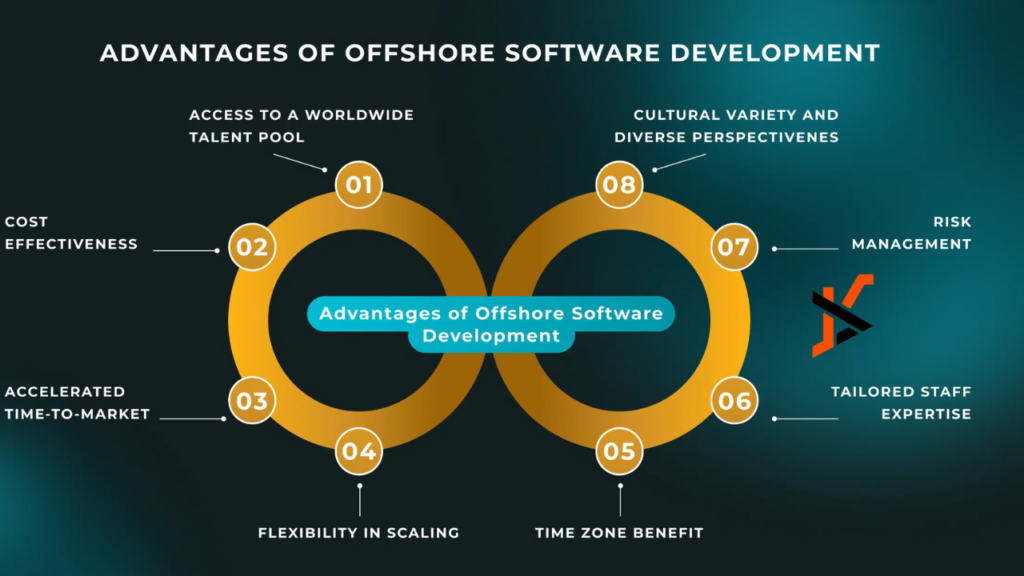After the quick transformation of the digital landscape of the time, organizations constantly look for methods of improving their IT processes. Offshore development center model (ODC strategy) has become the strategy of choice to allow organizations to access global talent, cut down on operation costs, and offer competitive responsiveness. As organizations are becoming more innovation-driven, the ODC strategy is at the center of transforming global IT strategies. This article discusses the revolutionary effect of ODCs, their advantages, and important points to consider while establishing a successful offshore development team.
Understanding the Offshore Development Center Model
What is an Offshore Development Center?
An offshore development center is a distant team that only does work for a single company from a foreign nation. Differently from usual outsourcing, when the projects are outsourced to third-party independent vendors, an ODC operates as an extension of one’s internal team, with greater control, openness, and inclusion.
Why Businesses Are Embracing the ODC Model
There are many reasons why companies are adopting ODCs, such as:
- Cost savings: Reduced labor expenses in foreign locations make ODCs economically justifiable.
- Access to talent: Businesses can leverage a worldwide talent pool of capable developers and IT experts.
- Scalability of operations: Enterprises can expand or diminish their staff according to project demand, making their operations scalable.
- Continuously running development cycles: Offshore teams facilitate 24/7 productivity across the globe.
Major Advantages of the Offshore Development Center Model
Cost-effectiveness and optimization of resources
Labor and infrastructure costs vary significantly across geographies. By setting up an ODC in a cost-effective geography, companies can save considerably on salaries, office rentals, and utilities without compromising on quality. This is cost-saving, and reallocates the use of resources to other strategic business functions.
Access to a Skilled Talent Pool
India, Mexico, and Ukraine are some of the nations famous for their world-class software developers and IT professionals. With ODCs, organizations have access to world-class global talent with expertise in advanced technologies like AI, cloud, and blockchain development.
Improved Business Continuity and Scalability
ODCs offer a safe environment for business continuity through the spreading of IT operations across different locations. This reduces the threat of regional disruptions, offering continuous project execution. Businesses are also able to expand their development teams in accordance with business requirements without long-term commitment, offering more scalability.
Full Control Over Operations
Unlike outsourcing where project delivery is owned by vendors, ODCs give businesses greater control over team recruitment, development approach, and technology stacks. This ensures that projects align with organizational goals and possess high-quality standards, directly impacting global IT plans.
How the ODC Model is Redefining IT Strategies
Enhancing Digital Transformation Plans
Digital transformation initiatives require cost-saving, expertise, and responsiveness. ODCs emerge as the main catalyst for innovation by supporting organizations in quick prototyping, experimentation, and releasing new technology and hence fuelling global IT strategy.
Driving Innovation and Market Expansion
By virtue of ODCs, businesses can penetrate new markets without physical offices. Offshore staff can also assist in localizing the product, tailoring solution by region, and delivering support tailored by different markets, stimulating innovation and enabling expansion to markets.
Enhancing Cybersecurity and Compliance
Compliance with regulations and data protection are the biggest risk issues for offshore operations. Global ODCs adopt global benchmarks like GDPR and ISO 27001 to protect data handling and follow local legislation. Businesses may adhere to tight cybersecurity guidelines not to take a chance, and ODCs in the businesses may become a likely reservoir of delectable IT strategy globally.
Establishing an Offshore Development Center: The Key Factors to Highlight
Choosing the Best Offshore Location
Location selection is crucial for the success of an ODC. Some of the most critical elements to look for are:
- Talent pool: Access to qualified developers and IT professionals.
- Cost saving: Low salaries and operating expenses in offshore markets.
- Time zone proximity: Proximity to headquarters to facilitate better time-zone collaboration.
- Business environment: Political stability, legal environment, and business ease.
Picking the Right Engagement Model
Companies can choose from some of the following ODC engagement models:
- Dedicated ODC: A full-time, onshore team serving one company.
- Build-Operate-Transfer (BOT): A firm sets up an offshore center, operates it, and then transfers it.
- Hybrid model: Blending in-house, nearshore, and offshore staff to maximize flexibility, with cost-effectiveness as well as scalability guaranteed.
Management and Optimization of ODC Operations
In a bid to ensure smooth interaction, organizations need to adopt best practices like:
- Use of agile practices and DevOps.
- Adopting project management tools like Jira, Trello, and Slack.
- Maintaining open communication channels and cultural assimilation initiatives for bridging geographical gaps.
- Conducting regular performance feedback and review cycles.
Offshore Development Center Trends of the Future
Nearshoring and Hybrid Strategies
Nearshoring becomes more critical as firms make a choice of greater time zone alignment and cultural proximity. Hybrid structures, bringing offshore, nearshore, and onshore workers together, offer greater scalability and flexibility as well as performance enhancement.
AI and Automation in Offshore Development
Artificial intelligence-based software development tools code, deploy, and test automatically. AI is increasingly being utilized by offshore teams to enhance productivity and workflow management, enhancing IT strategies globally.
Sustainability and Responsible Outsourcing
Companies these days are combating ethical outsourcing with socially responsible cultures, equitable wages, and promoting sustainable enterprise practices abroad. International IT strategies that include sustainable as well as socially responsible business practices are the domain of only this practice.
Conclusion
Offshore development center model is revolutionizing worldwide IT strategy by providing business houses cost-effective, scalable, and innovation-driven solutions. With the speed of digital transformation speeding up, ODCs are bound to lead the way in creating the future of software development. By following a strategic strategy in selecting locations, streamlining operations, and keeping themselves abreast of emerging trends, business houses can gain maximum advantages from offshore development and lead the way in the IT sector.

